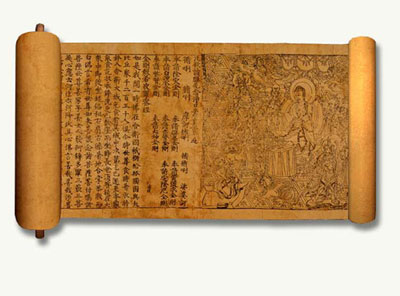

The transcription, as a kind of pilgrimage souvenir, documents the monk’s physical presence at the site of the icon’s miraculous appearance. While their shared subject matter speaks of the Fanhe icon’s lasting regional importance, the embroidery and stele transcription diverge in their relationship to the concept of place. This famous image was said to have emerged from the living rock of a mountain at Fanhe some 850 kilometers from Dunhuang, near present-day Wuwei, serving as a barometer of political rectitude by losing its head during periods of turbulence. The buddha standing in the center above the row of lay and monastic donors is a depiction of the very miraculous icon housed in the temple where Daozhao, our pilgrim, copied the stele. Looking up from the case and down into the next gallery, the luster of a spectacularly large eighth-century silk embroidery registers at roughly eye level. Image © The Trustees of the British Museum. Silk thread on silk with hemp backing, 94 7/8 x 62 5/8 in. 700s, Mogao Grottoes Cave 17, Dunhuang, Gansu Province, China. The association between Daozhao and the painted pilgrim monk is less straightforward than it may initially seem.Įmbroidery of the Fanhe Buddha (detail), the miraculous icon commemorated in the stele, ca. The monk here, moreover, is depicted with the generic period physiognomy for Dunhuang representations of Central Asians. However, as demonstrated by the many examples of this icon from across East and Inner Asia, it is often unclear whether he was meant to represent a specific historical traveler or a venerated archetype.

To the right, the drawing of a pilgrim monk suggests an immediate connection-it is easy to imagine him carrying a similar travel document among the scrolls on his open-frame pack. The manuscript’s significance extends far beyond the object itself, and it charts its own exquisite path through the Research Institute galleries. Ink and pigments on paper, 16 1/8 x 12 3/16 in. 851–900, Mogao Grottoes Cave 17, Dunhuang, Gansu Province. Moreover, the image of Buddhism that emerges is more fluid and inclusive than modern divisions along doctrinal or linguistic lines suggest. Upon the manuscript’s disassembly, a tantric ritual text in Tibetan was revealed, in turn, on the back of the Chinese scripture.Ĭomprising four very different texts in two languages, this object in its totality produces flashes of insight into life in the 10th-century Hexi corridor, for example, in the pervasive importance of Tibetan language and culture. These two texts were attached to part of a Chinese Buddhist scripture. This transcription, which commemorates a famous temple in the Hexi corridor, supplies what scholars think was the pilgrim monk’s name, Daozhao, and a date of 968. In its original mounting, a handwritten copy of a Chinese stele inscription appeared after the letters and jottings. The document on view is, in fact, just one part of a much larger and more complex manuscript that was disassembled for conservation purposes after being taken to London in the twentieth century. 968, Mogao Grottoes Cave 17, Dunhuang, Gansu Province, China. (See Manuscripts and Travellers, 2011, by Sam van Schaik and Imre Galambos, for more on this- most of the information about the manuscript in this post is indebted to this comprehensive study.) The texts’ seemingly haphazard sequence and placement turn out to be crucial for reconstructing the pilgrim’s journey.

The manuscript, it seems, was a collection of copies and notes carried by the pilgrim throughout his travels rather than a formal document presented to regional authorities. Just a casual glance at this document suggests there is more to the story than simply the letters’ content-for example, the handwriting is inconsistent, entire lines of text have been effaced, and Chinese characters are interspersed between the Tibetan-language letters seemingly at random. As the label indicates, it bears letters of introduction for a Chinese monk on pilgrimage to India, the birthplace of Buddhism, requesting shelter and guidance from temples along the way. Entering the Getty Research Institute galleries in the exhibition on the famous Buddhist site of Dunhuang, we first encounter a document on tattered paper somewhat larger than a placemat.


 0 kommentar(er)
0 kommentar(er)
